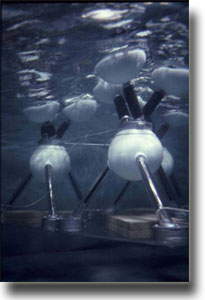

|
| Open Menu |
| Local page - | New energy menu - | Science and Technology - | Economy menu - | Food & Restaurants - | General menu |
| More classified links |
"Pelamis is the world's most advanced wave energy technology company. The Pelamis is an offshore wave energy converter that uses the energy of ocean waves to generate electricity. Offshore wave energy has the potential to be one of the most environmentally benign forms of electricity generation. |

"Marine Current Turbines Ltd (MCT) has a demonstrated pedigree of pioneering the development of tidal stream generation technology for over 20 years. Now under the ownership of the Siemens, MCT is poised to become the World's leading OEM (Original Equipment Manufacturer) of commercial scale tidal stream technology, dedicated to research, design, manufacture and support of tidal stream energy generating systems. |

|
Blue Energy |
|

Ocean Wave Energy Company |
|
 
OpenHydro |
"Ocean Power Technologies (OPT) is a leading renewable energy company specializing in cost-effective, advanced, and environmentally sound wave power technology. OPT's PowerBuoy system integrates patented technologies in hydrodynamics, electronics, energy conversion, and computer control systems to extract the natural energy in ocean waves. The result is a leading edge, ocean-tested, proprietary system that turns wave power into reliable, clean, and environmentally beneficial electricity." more |
BioPower Systems |

AWS Ocean Energy Ltd. |

Aquamarine Power story |

Carnegie Wave Energy Limited |
The Wavebob wave energy converter |

The Vortex Hydro Energy |

Anaconda |
WaveRoller |

AW-Energy |

OceanEnergy is a world leader in Innovative Renewable Energy within the wave energy industry. |

Ocean Thermal Energy Conversion |

Searaser |

Eco Wave Power, The Wave Clapper |

S.D.E. |
The DEXAWAVE |

British Hydropower Association (BHA) |

Neptune Wave Power |

Wave Hub |
Clic
for your Research of books on Amazone about: The Hydro Energy |
|
Amazone : Ocean Energy - Wave Energy
- Wave Energy - Tidal energy for electric power plants
- Tidal energy for electric power plants
|
|
| Directories : | Yahoo: Energy - Hydropower MSN: Hydropower Energy Demoz: Renewable Energy - Hydro Energy - Ocean Sources |
 
Copyright WaoLine, The Internet Interactive and Dynamic Visual Directory |